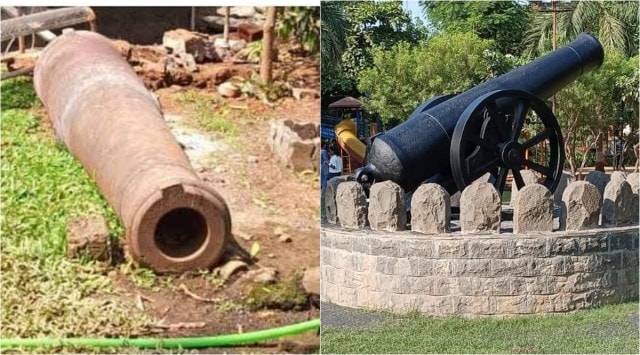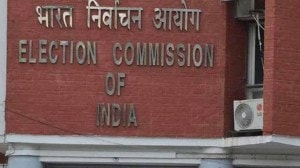BMC restores two 167-yr-old cannons unearthed in Ghatkopar garden
Seeking to preserve these important artefacts of the city's past, the Brihanmumbai Municipal Corporation (BMC) has now restored the cannons back to their original glory.
 A cannon found buried in marshy soil; (right) after its restoration by the BMC. (Express Photo)
A cannon found buried in marshy soil; (right) after its restoration by the BMC. (Express Photo) What may have once been perched atop Mumbai’s forts, two 167-year-old cannons were discovered in dilapidated condition at Ghatkopar’s Lion’s Children Park a few years ago.
Seeking to preserve these important artefacts of the city’s past, the Brihanmumbai Municipal Corporation (BMC) has now restored the cannons back to their original glory.
Revived by the BMC’s Heritage Cell at a cost of Rs 38 lakh, the work on the restoration project commenced in 2022 after the civic garden discovered the canons and approached the heritage cell to undertake the refurbishments.
“We were inspecting the lawn when we found that the cannons had been buried in muck,” said Jeetendra Pardeshi, superintendent of Gardens and Tree Officer for BMC.
According to senior officials of the civic heritage cell, the cast iron cannons had been built in 1856 and are 3.10 metres in length and 0.64 metres in diameter. While one of the restored cannons has been relocated to Dr Keshav Baliram Hedgewar Park in Ghatkopar, the other continues to be housed at Lion’s Children Park, where they were first discovered.
While the date engraved on the canon’s surface revealed its year of establishment, how and when the cannons made their way to Ghatkopar remains a mystery. City historian Chandan Vichare told The Indian Express, “While cannons are used in warfare, they weren’t used anytime in Mumbai’s history. The city has 11 forts and these canons had been placed there to keep a watch on enemies.”
“Most of the canons had been buried into the ground by the British authorities before they left”, said Vichare, adding that the buried canons remain scattered across the city, including Dr Ambedkar Road in Parel, Masjid Bunder and the path behind Gateway of India amongst many other locations.
Madhavi Deo, designer on the restoration project, said that when the cannons were discovered, they were buried in marshy soil and the barrels were filled with mud. “These canons weigh approximately five tonnes each. They were extracted using cranes. The pattern for cannon carriage was made first in wood and later, cast in aluminium and iron. The stoppers which had been broken over a period of time, were recreated. Besides this, the gun surface was cleaned and oxidised,” Deo told The Indian Express on Monday.







